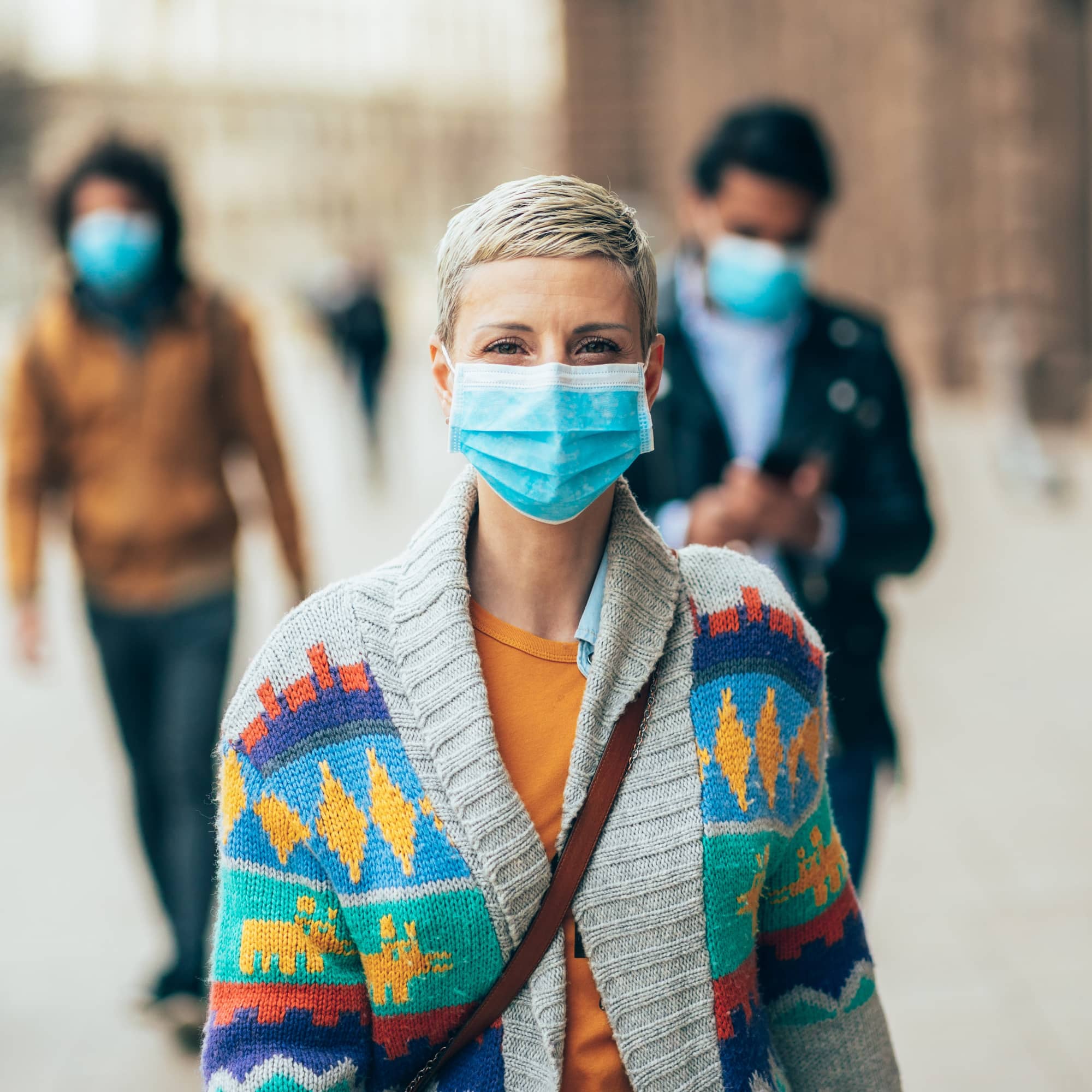
- POPSUGAR Australia
- Fitness
- The CDC Officially Acknowledges That Masks Protect Wearers Themselves From COVID-19
The CDC Officially Acknowledges That Masks Protect Wearers Themselves From COVID-19

Update, Nov. 11: In a scientific brief published on Nov. 10, the CDC acknowledged that masks not only protect those around you from getting COVID-19 if you are in fact infected, but that they also protect the wearers because of filtration. Masks, the agency says, help reduce inhalation of virus-containing droplets, “including filtration of fine droplets and particles less than 10 microns.” The filtration capabilities of masks are increased when there are multiple layers of cloth with higher thread counts as opposed to single-layered cloth masks, the CDC states, adding that some materials such as polypropylene may enhance filtration. Further research, the agency noted, is needed to expand evidence and pinpoint the best materials for both blocking and filtration of viral particles.
These statements by the CDC only further make a case for universal masking. The statements are also good for public health messaging. “We don’t have people yet who are completely convinced about the benefits of masking until they see the CDC say that it also protects you and your family,” Monica Gandhi, MD, MPH, an infectious disease expert at the University of California, San Francisco, told The New York Times. “I would encourage every American to adhere to masking guidelines now that we hear more clearly today that this will protect you and others.”
Original post, July 28: Experts have been recommending face masks as a way to prevent the spread of the coronavirus; the wearer of the face mask can protect people around them because the mask blocks respiratory droplets, which have been identified as a main means of COVID-19 transmission. But could wearing a face mask also protect the wearer? It’s a possibility, according to a new paper from researchers at the University of California – San Francisco and John Hopkins, which will be published in the Journal of General Internal Medicine.
The paper draws on “virologic, epidemiologic, and ecologic evidence” to make the argument that wearing a face mask could result in a lower “viral dose,” or amount of coronavirus particles, taken in by a wearer exposed to the virus. And according to several studies cited by the researchers, a lower viral dose can lead to less severe symptoms, or even no symptoms at all, of a given illness, including COVID-19.
One cited study, published in May, tested this with the coronavirus and hamsters. Researchers in China set up cages of hamsters, some infected with the coronavirus and others healthy, and separated the two groups with partitions of surgical masks in some of the cages. In citing this study, the UCSF and Johns Hopkins scientists noted that the healthy hamsters were “less likely to contract SARS-CoV-2 infection with a surgical mask partition,” and those that did had a milder infection compared to their “non-masked” peers.
The researchers also looked at large-scale coronavirus data from before and after face masking was widely practiced. A pre-masking review, they noted, estimated that 15 percent of COVID-19 cases were asymptomatic. A more recent review has placed that number as high as 40-45 percent, and the CDC has agreed that asymptomatic infection is around 40 percent. In the closed setting of a cruise ship, this narrative has also played out. An estimate in March put rates of asymptomatic infection on the Diamond Princess cruise ship at around 18 percent. On a more recent cruise, all passengers and staff were given masks after a positive case was identified onboard. While 128 out of 217 passengers eventually tested positive, 81 percent of them remained asymptomatic.
Related: A Doctor Explains Why You Should Social Distance Even While Wearing a Face Mask
While this evidence is indirect, the researchers drew on it to hypothesize that face masks could play a role in increasing the proportion of cases that are asymptomatic, which, though problematic for transmitting the virus, could help communities reach herd immunity without large amounts of severe cases.
And it could even go beyond that, they suggest. Again noting that the evidence was indirect and likely impacted by multiple factors, the researchers nonetheless noted that countries with population-level masking have had more success in reducing death rates from COVID-19. “Indeed, even when cases have resurged in these areas with population-based masking upon re-opening (e.g. South Korea, Singapore, Hong Kong, Taiwan), the case-fatality rate has remained low with opening but masking,” the researchers wrote. Their argument is that masking could not only lead to a higher proportion of asymptomatic coronavirus cases, but also ultimately decrease death rates.
Again, asymptomatic infection is a double-edged sword. It can increase the spread of the virus, researchers wrote, but at the same time, “exposing society to SARS-CoV-2 without the unacceptable consequences of severe illness . . . could lead to greater community-level immunity and slow down spread as we await a vaccine.” And they add that “masks, depending on type, filter out the majority of viral particles, but not all,” thus increasing the chance of a less-dangerous asymptomatic infection versus a severe one.
Much of the evidence cited doesn’t establish a cut-and-dry, cause-and-effect correlation between masking and a lower viral dose, and between masking and asymptomatic infections. In a New York Times article about the paper, some experts expressed caution about the conclusions, while others said it makes “complete sense” that masking would protect the wearer to some degree. While more research is needed to nail down the UCSF-Johns Hopkins conclusions, the paper does provide yet another motivation to continue masking up: not only does it protect others, but it may also extend a measure of safety to you, the one wearing the mask.
– Additional reporting by Sam Brodsky
Related: Bill Nye Shares a PSA About the Effectiveness of Different Face-Mask Styles

